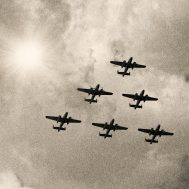O-Rings have played a major role in both military advancement and civilian technology. These unassuming circular seals have revolutionized fluid containment systems across countless applications, creating reliable hydraulic and pneumatic systems where previous technologies failed. Apple Rubber, like many precision manufacturers, stands on the shoulders of innovations that began with military applications.
The Danish Pioneer Behind Modern Sealing
The o-ring traces its origins to Danish inventor Niels Christensen, whose inventive spirit led to numerous breakthroughs, including an improved brake system for streetcars in the 1890s. However, his most enduring contribution came from a persistent challenge: creating a reliable seal for hydraulic systems that maintained fluid containment while allowing for mechanical movement.
Working at Midland Steel Products in Cleveland during the 1930s, Christensen methodically tested various rubber ring configurations and groove designs. His breakthrough came with a simple yet elegant solution—a circular rubber ring seated in a groove 1.5 times the ring’s radius. This fundamental design principle, patented in 1937 when Christensen was 72 years old, continues to guide manufacturers like Apple Rubber.
Military Adoption and Acceleration
The o-ring’s journey from invention to widespread use accelerated dramatically with military interest. As World War II approached, President Roosevelt’s military buildup created urgent demand for reliable, mass-producible components for aircrafts.
In June 1940, a pivotal demonstration at Wright Field showcased the o-ring’s potential. Army engineers installed Christensen’s seals in the landing gear of a Northrop A-17A, which then completed 88 consecutive takeoffs and landings without failure—a very impressive performance for the technology of the time.
The military quickly recognized the value of the o-ring, purchasing Christensen’s design for $75,000 (equivalent to $1.3 million today) and integrating o-rings into aircraft systems. Within just two years, every American military aircraft incorporated these seals in the hydraulic systems used to control landing gear, flaps, doors, and bomb bays.
Innovation Through Military Demands
Military requirements pushed o-ring technology forward at an unprecedented pace. The extreme conditions of warfare—from high-altitude cold to desert heat, from precise tolerances to prolonged missions—created testing grounds that accelerated material science and design improvements.
Using slow-motion photography to analyze o-ring performance under stress, manufacturers developed better compounds and specifications. These improvements didn’t just prevent costly breakdowns and repairs; they potentially saved countless lives by enhancing aircraft reliability and extending their operational capabilities.
The Legacy in Modern Manufacturing
Today, companies like Apple Rubber continue this tradition of innovation, developing specialized compounds and manufacturing techniques that build upon those military-driven advances. From aerospace applications to medical devices, the precision engineering originally demanded by military specifications has elevated quality standards across countless industries.
The humble o-ring exemplifies how military necessities often drive technological advancement with far-reaching civilian benefits. As manufacturers continue to push the boundaries of what’s possible with elastomer technology, they honor the legacy of innovation that began with a Danish inventor and was perfected through military applications.
